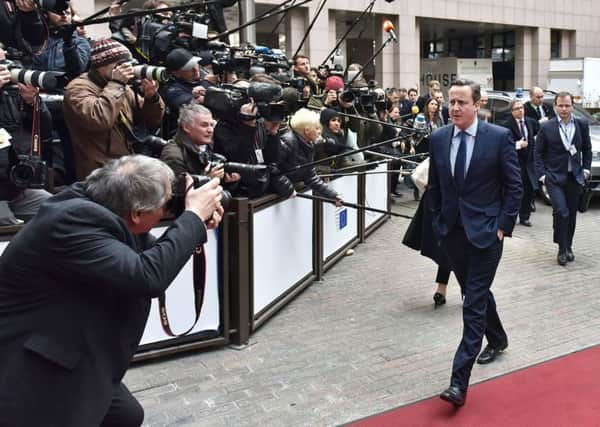Mark Stuart: Can David Cameron win his EU referendum gamble?


Having taken a successful punt over the Scottish referendum in 2014, the Prime Minister is chancing his luck again over the European Union referendum.
Although he might think the EU vote is a wager he can win, the process is fraught with political risks.
Advertisement
Hide AdAdvertisement
Hide AdThe draft deal that David Cameron secured might, at first, appear to have strengthened his chances of success in the referendum. But, as the Brussels summit has now shown, it will become clear during the forthcoming campaign that nothing has been finalised.
Even after a “Yes” vote, institutions like the European Parliament will have to agree to Britain’s proposals.
Mr Cameron is therefore asking the British voter to share in his blind faith that the EU will not unpick the deal.
However, Mr Cameron has learned one important lesson from the Scottish independence referendum: not allowing one’s opponents two years in which to espouse their cause.
Advertisement
Hide AdAdvertisement
Hide AdRealising his mistake, voters will only be allowed a four-month campaign, surely not enough time for the “Leave” campaign to build up a significant and sufficient head of steam.
But what if the EU migration crisis worsens over the summer and hundreds of thousands of desperate people arrive on our shores?
In such circumstances, don’t rule out a groundswell of nationalist feeling that could tip the balance in favour of those wanting to leave the EU.
The Prime Minister may feel that he is enjoying something of a honeymoon, having won an overall majority at last year’s general election, but that is no guarantee of an easy referendum victory.
Advertisement
Hide AdAdvertisement
Hide AdYes, Tony Blair’s honeymoon contributed to the 3-1 “Yes” result in the Scottish devolution referendum in September 1997, but a week later, the Welsh voted “Yes” by fewer than 7,000 votes.
In fact, the risks to Mr Cameron are greater than those faced by Mr Blair.
There is a real danger that voters will use the EU referendum to give his government a kicking.
Ask Nick Clegg.
The Alternative Vote (AV) Referendum in May 2011 ended up with Labour voters punishing the Deputy Prime Minister over his introduction of tuition fees rather than being a sober assessment of the merits of the case for electoral reform.
Advertisement
Hide AdAdvertisement
Hide AdThe pattern to most referendums is that the gap between the two sides tends to narrow during the campaign, but in the final week, voters stare over the precipice and pull back from taking the riskier option.
That was the experience in both the Quebec referendums (1980 and 1995) and in Scotland in 2014.
But there are still risks for Mr Cameron.
A close result could result in a “neverendum” scenario where the “No” camp demand a re-run.
We have already seen that happen north of the border.
As Mr Cameron surveys the disarray of the “Leave” side, currently split into two rival campaigns, he will feel confident of victory.
Advertisement
Hide AdAdvertisement
Hide AdHe has a point. Looking back to the 1975 EEC Referendum, the “No” camp contained a ragbag of extremists from the political right (including Enoch Powell) and the extreme left (Tony Benn).
The public prefer sensible moderates. In 1975, it was Edward Heath, William Whitelaw and Roy Jenkins; this time around it is Mr Cameron, Alan Johnson (heading the Labour “Yes” campaign) and the former Chancellor, Kenneth Clarke.
It is also true that the “Leave” campaign currently lacks a moderate figurehead.
Nigel Farage of Ukip may prove effective in winning over older Labour voters in the North, but he is widely seen as a divisive figure.
Advertisement
Hide AdAdvertisement
Hide AdAs such, Mr Cameron is fully aware of the need to persuade his “big beasts” like Boris Johnson, Michael Gove, Theresa May and Sajid Javid to stick with him on the “Yes” side.
Each of these figures is worried about their potential prospects in a Conservative leadership contest that has to take place before 2020, Mr Cameron having pre-announced his intention to retire during last year’s general election campaign rather than retaining his right to keep his options, and intentions, open.
At the moment, none of these Cabinet heavyweights has shown a willingness to break ranks. But what if they do? Suddenly, the odds would lengthen on Mr Cameron winning his EU gamble.
Even if none of the front four in the Tory leadership betting joins the “Leave” campaign, someone else could emerge from the pack of more junior ministers to argue for a “Brexit”.
Advertisement
Hide AdAdvertisement
Hide AdCould for instance, Priti Patel, the Minister of State for Employment, emerge as a serious leadership contender were she to perform well on the “Leave” side?
Mr Cameron is deluding himself if he thinks that by holding the referendum and allowing his Cabinet to join whichever side they like that he will keep his fractious party united.
In 1975, Harold Wilson’s initial hopes of healing the wounds in the Labour Party were wiped out by 1981 when two dozen pro-European figures joined the breakaway Social Democratic Party (SDP).
So, Mr Cameron is about to embark on what amounts to his biggest ever political gamble. If he wins the EU referendum, he will be remembered as the Conservative Prime Minister who saved two Unions – with Scotland and with Europe.
Advertisement
Hide AdAdvertisement
Hide AdIf his gamble fails, both Unions would collapse and his immediate resignation would almost certainly follow.
Mark Stuart is a political academic from York who has written biographies of John Smith and Douglas Hurd.